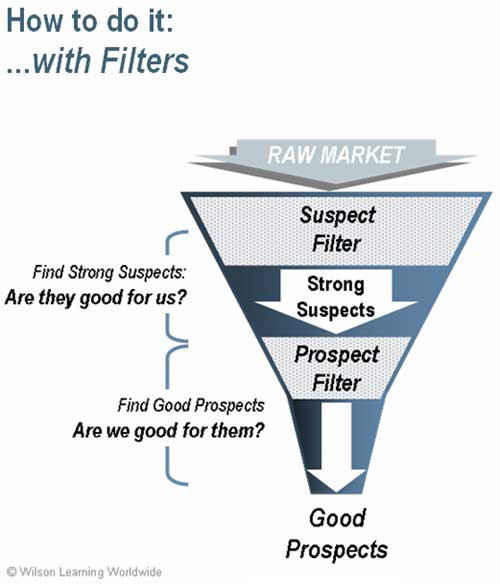If yours is like a lot of sales organizations, it may have intensified prospecting efforts lately as old customers downsized, cut spending, and, in some cases, went out of business.
The problem is that prospecting is often time-consuming, costly, wasteful, and hard on the sales team's morale. Why?
Consider a couple of typical tips for successful prospecting: "Schedule a minimum of two hours a day for phone calling"; "Spend the first 30 minutes of each day making at least three calls."
The idea is that if you make enough calls, sooner or later a certain percentage will result in meetings, and a certain percentage of those will result in sales.
The fundamental flaw in that strategy explains why most salespeople hate prospecting: They hear a very large number of "No's" for every "Yes."
If the great majority of their calls are to people who have no interest in their offering, then the time they spend has little effect other than to lower motivation and drive up the cost of sales.
Consider another set of numbers: As a rule, the ratio of unscreened suspect-to-prospect is 10:1, with a prospect-to-sale ratio of 3:1. Which means that the suspect-to-sale ratio is 30:1.
With such a low success rate in reaching real prospects, little time or energy is left for the sales calls that bring in revenue. That is the "numbers trap."
Clearly, it's vitally important to maintain a healthy pipeline of prospective business—especially when established customers are cutting budgets and delaying spending. So what's the alternative to the traditional "dialing for dollars" approach?
Step 1: Stop Chasing Numbers
Well-prepared, experienced professionals do not waste time calling on weak prospects. Their solution is to identify the strongest prospects first—by adopting a strategy focused on quality rather than quantity.
By investing a little more time upstream, the yield downstream is not just a larger number of prospects but a larger number of good prospects. Those are the ones who are not only more likely to buy but also more likely to buy from you.
The secret? Find the customers who meet two simple criteria: They are good for you, and you are good for them.

Step 2: Identify Quality Suspects
Rather than placing every possible company in a territory on an indiscriminate list of suspects, a screening process should take place. Based on the first of the criteria mentioned above, ask, "Which of the prospects are most likely to be good for us?"
To answer that question, each "suspect" company should be carefully vetted through pre-call research and compared with a profile identifying what's most important for your organization in predicting the probability of a sale.
For example, you might be asking whether there is evidence that a company...
- Matches your economic and strategic priorities
- Has the right level of profitability and a probability of buying from you
- Matches your industry/market-segment requirements
- Is in the right geographic location
- Has healthy annual sales/net income and is the right size
- Has the budget and ability to spend for what you sell
Once those questions have been answered for each suspect, the list should be sorted, and companies that don't meet the "good for us" criterion should be discarded. The remainder will constitute your shortlist of potential prospects.
When you put in the time to develop a higher-quality list, your salespeople can make earlier "go/no-go" decisions that will help them avoid expensive efforts to contact customers who are never going to buy from you.
Step 3: Find Your High-Quality Prospects
Remember, to make the shortlist of strong suspects, a company has to match the profile of a good prospective customer for your organization.
Before qualifying as good prospects, your suspects need to pass the second test: Are you good for them? That requires asking a different set of questions, focused on understanding how you can deliver high value a customer would be willing to pay for.
As a prerequisite to developing a final list of good prospects, your sales team should be able to answer the following questions:
- What's our unique value?
- What business problem do we solve?
- What are they able to do with our solution?
- What do we improve or increase? What do we decrease?
- What's important to the customer?
Once the answers to those questions are clear, they should be linked or matched to each suspect on the list, and when a good match is found that company should be promoted to the prospecting list.
Step 4: Select the "Quality Few" to Contact
If good information has been gathered to answer the critical questions about each potential suspect, the outcome should be a good, high-quality list of prospective customers. Those are companies that have a high probability of being able to buy your solutions and are also likely to receive high business value from your solutions.
When your salespeople use that approach to select a small number of well-qualified companies to call based on those criteria, they will be far better able to make a credible business case for a meeting. They are more likely to be granted an appointment for a real sales call, rather than wasting their own valuable time and that of a contact who has neither the budget nor the interest required to justify a conversation.
The result of escaping the numbers game is to decrease the suspect-to-prospect ratio, increase the prospect-to-sale ratio, and achieve an overall increase in the value of each new sale.



